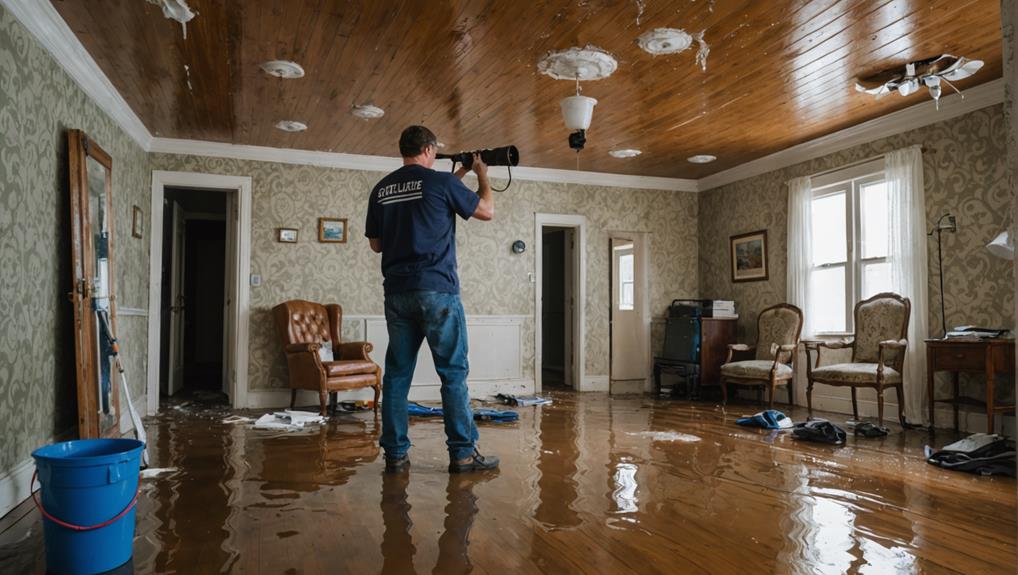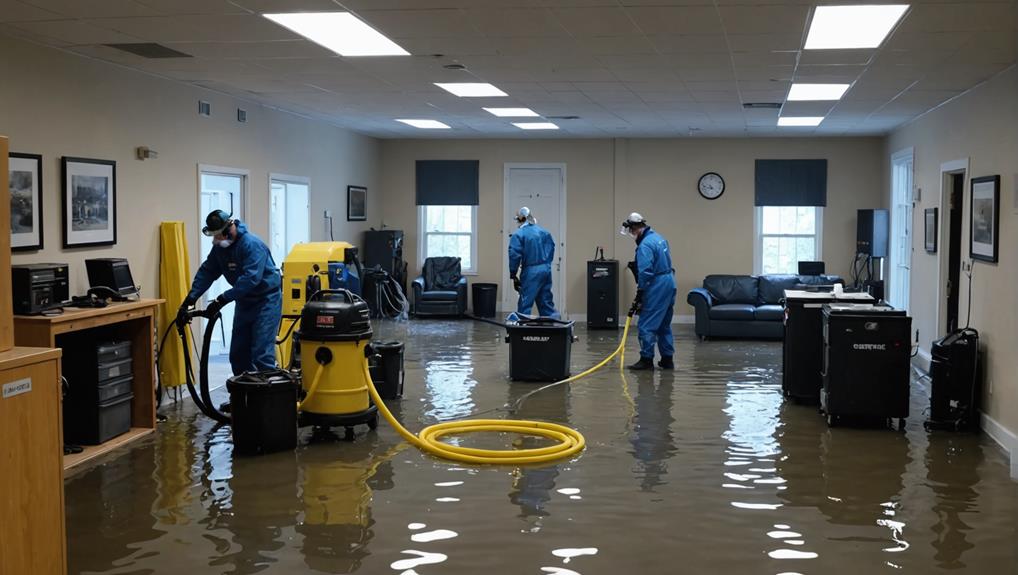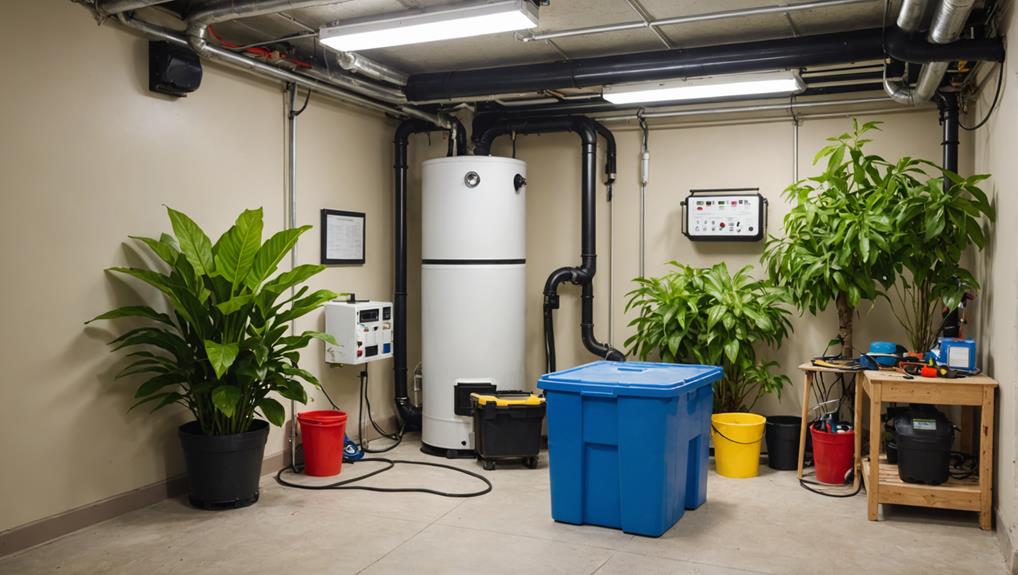Restoring your home after water damage involves careful assessment and action. First, document the affected areas for insurance claims and identify the source of the water intrusion. Safety is key: inspect structural integrity, and use protective gear during cleanup. Extract water quickly using sump pumps or vacuums, and then focus on drying the space thoroughly with dehumidifiers and fans. Clean and sanitize surfaces, addressing any mold issues promptly. Finally, evaluate for any structural repairs needed and implement preventive measures for the future. You're on the right path to recovery, and there's a lot more to investigate about this process.
Assessing the Damage

When faced with water damage, it's crucial to assess the extent of the destruction before diving into repairs. Start by documenting the affected areas—take photos and jot down notes. This damage assessment is fundamental for both your understanding of the situation and for filing insurance claims later. You'll want to pinpoint the source of the water intrusion, whether it's a burst pipe, roof leak, or flooding.
Next, check for structural integrity. Look for warped floors, discolored walls, or damp insulation. These indicators can reveal the depth of the damage. It's important to understand that what you see on the surface may only tell part of the story; hidden issues could be lurking beneath.
While maneuvering through this process, remember to stay connected with your insurance provider. They often have specific requirements for claims, and having thorough documentation will strengthen your case. It's perfectly normal to feel overwhelmed, but taking these initial steps can help you regain a sense of control. Your home is a sanctuary, and addressing water damage with care will lead you toward restoration and peace of mind.
Safety Precautions First
Before you begin any restoration work, it's vital to assess the structural integrity of your home to guarantee it's safe for entry. Furthermore, protecting your personal health is paramount, as exposure to mold and contaminated water can pose serious risks. Taking these precautions will help you navigate the restoration process more safely and effectively.
Assessing Structural Integrity
How can you guarantee your home is safe after water damage? Start with a thorough evaluation of your home's structural integrity. It's vital to conduct a foundation inspection, checking for any cracks or shifting that may have occurred because of excess moisture. Pay attention to load-bearing walls, as they're fundamental for your home's stability.
Next, utilize moisture mapping tools to pinpoint areas with hidden water intrusion. This process involves identifying damp spots behind walls and under flooring, making certain no lingering moisture compromises your home's frame. Remember, even small amounts of water can lead to serious structural issues if not addressed.
As you evaluate, trust your instincts. If something feels off, it probably is. Document your findings and consult with professionals if you notice any significant concerns. They can provide a thorough evaluation and recommend necessary repairs.
Your home is more than just walls; it's where memories are made. Taking these steps not only protects your investment but also guarantees your space remains a safe haven for you and your loved ones. Prioritize safety by being proactive in evaluating your home's structural integrity after water damage.
Protecting Personal Health
Ensuring your personal health after water damage is vital, especially since hidden hazards can arise from mold and contaminated water. Mold can develop within 24 to 48 hours, leading to serious respiratory issues and other health problems. To protect yourself, it's important to prioritize mold prevention strategies. Start by addressing any moisture sources immediately; this includes repairing leaks and ensuring proper drainage.
While you're working on restoration, wear protective gear like masks and gloves to minimize exposure to harmful spores and bacteria. Ventilating the area is likewise important for improving air quality. Open windows and use fans to circulate fresh air, reducing the concentration of pollutants.
Consider using dehumidifiers to maintain an ideal humidity level of 30-50%, which helps inhibit mold growth. Regularly monitor your home for signs of mold, such as musty odors or discoloration on surfaces. If you detect mold, it's best to consult professionals for safe removal.
Ultimately, by taking these safety precautions, you're not just restoring your home but equally safeguarding your health and well-being. Remember, your comfort and safety should always come first during the recovery process.
Water Extraction Methods

When faced with water damage, swift and effective water extraction is crucial to minimize further destruction and prevent mold growth. You'll need to act quickly, using the right methods to guarantee your home begins to heal. Here are some common water extraction methods:
| Method | Description |
|---|---|
| Sump Pumps | These devices remove water from basements or crawl spaces, efficiently pumping it away from your home. |
| Wet/Dry Vacuums | Ideal for smaller areas, these vacuums can tackle water on floors, carpets, and other surfaces. |
| Flood Barriers | Utilizing barriers can prevent water from entering your space, providing a first line of defense during severe storms. |
| Professional Services | Hiring specialists guarantees thorough extraction and access to advanced equipment for larger floods. |
| Manual Extraction | In some cases, using buckets or mops may be necessary for smaller spills or tricky spots. |
Each method has its place, depending on the severity of the water intrusion. By understanding your options, you can take the necessary steps to protect your home and restore it to its former state. Remember, every moment counts in this process.
Drying and Dehumidifying
Effective drying and dehumidifying are critical steps in the home restoration process after water damage, and acting within 24 to 48 hours can greatly reduce the risk of mold growth. To guarantee your home returns to a safe environment, you'll need to focus on a few key aspects.
- Choose the right dehumidifier: Depending on the size of the affected area, select a unit that can effectively handle the moisture levels.
- Set up moisture monitoring: Use hygrometers to track humidity levels and guarantee they stay within a safe range.
- Increase air circulation: Open windows and use fans to promote airflow, which helps speed up the drying process.
- Remove saturated materials: Carpets, insulation, or drywall that can't be dried quickly should be removed to prevent further issues.
- Regularly check for dampness: Keep an eye on surfaces, guaranteeing they're drying properly and there are no hidden pockets of moisture.
Cleaning and Sanitizing

After water damage, the significance of thorough cleaning and sanitizing can't be overstated. It's crucial to tackle this step proactively to prevent mold growth and guarantee your home is safe and livable. Start by evaluating the affected areas; any standing water needs to be removed immediately. If your situation involves sewage cleanup, take extra precautions. Contaminated water poses serious health risks, so use appropriate protective gear, including gloves and masks.
Once the area is dry, focus on mold remediation. Mold can develop within 24-48 hours, so act quickly. Use a mixture of water and detergent to clean surfaces, and consider using a specialized mold remover for stubborn spots. For porous materials like drywall or carpeting, replacement might be necessary, as they can harbor mold spores.
After cleaning, don't skip the sanitizing step. Utilize EPA-approved disinfectants to treat surfaces, guaranteeing you eliminate any lingering bacteria or pathogens. This process not only restores your home's safety but likewise provides peace of mind. Remember, thorough cleaning and sanitizing are your best defenses against further damage and health hazards. You're creating a fresh start after a challenging experience.
Repairing Structural Damage
Once you've tackled the cleaning and sanitizing, the next step involves evaluating and repairing any structural damage caused by the water intrusion. It's essential to assess how deeply the water has penetrated your home's framework. This is where foundation repairs and wall reinforcement come into play, ensuring your home is safe and sound.
Here are some key areas to focus on:
- Inspect for cracks in the foundation or walls that may have developed.
- Assess the framing of your home, as water can weaken wood structures.
- Check insulation for mold or rot, and replace it if necessary.
- Evaluate flooring for warping or buckling that may require support.
- Consult a professional when in doubt, especially for significant repairs.
Addressing these issues promptly can prevent further complications down the line. Remember, your home is more than just a structure; it's a sanctuary. By investing the time and effort into these repairs, you're not just restoring its physical integrity but also reinforcing the emotional comfort it provides.
Preventing Future Water Issues

Water damage can be a recurring nightmare for homeowners, but implementing preventive measures can greatly reduce the risk. Start by evaluating your property's drainage solutions. Verify that gutters and downspouts are clean and directing water away from your home's foundation. Installing extensions on downspouts can further help in diverting water and preventing pooling.
Moreover, consider grading your yard to slope away from your foundation, allowing rainwater to flow away naturally. You might also investigate waterproofing techniques for your basement or crawl space. Applying a waterproof sealant on exterior walls can create an effective barrier against moisture intrusion.
Inside, regularly inspect plumbing for leaks or signs of wear. Don't ignore little drips; they can lead to bigger problems over time. If you have appliances that use water, like washers or dishwashers, consider smart leak detection systems that alert you to issues before they escalate.
Lastly, investing in sump pumps or backflow valves can provide extra protection against flooding, especially in areas prone to heavy rainfall. By being proactive with these measures, you're not just protecting your home; you're safeguarding your peace of mind.
When to Call Professionals
How can you tell when it's time to bring in the experts for water damage restoration? As a homeowner, you might feel overwhelmed by the aftermath of a leak or flood. Knowing when to reach out for professional help can make a significant difference in your recovery process.
Consider calling emergency services if you notice any of the following:
- The water has spread beyond a small area.
- There's visible mold growth within 24-48 hours.
- You can't identify the source of the water damage.
- The damage involves electrical systems or appliances.
- Your home's structure appears compromised.
Homeowner experiences vary, but ignoring these signs can lead to further damage and health risks. Professionals have the tools and expertise to assess the situation accurately, ensuring that your home is safe and structurally sound. They can likewise assist in preventing future issues, providing you with peace of mind.
Ultimately, trusting your instincts is crucial. If you're feeling uncertain or anxious about the extent of the damage, it's always better to err on the side of caution and consult with a professional. Your home deserves the best care possible.
Conclusion
Restoring your home after water damage can be overwhelming, but taking it step by step makes it manageable. Did you know that 1 in 50 homeowners file a water damage claim each year? This highlights how common the issue is, but with proper assessment, extraction, and repair, you can reclaim your space. Remember, while DIY efforts can be effective, don't hesitate to call professionals if the damage is extensive. Your home deserves the best care possible.
